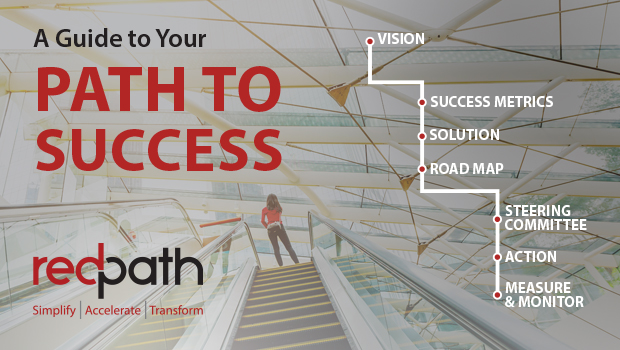Redpath panel recap: Building your CRM strategy
Whether it’s an integrated platform like Salesforce or a series of spreadsheets, every organization needs a strategy to power its CRM system. Yet many companies struggle to institute this essential component. That’s why Redpath hosted a live panel event, last week in Minneapolis, to discuss the framework and best practices for creating your own CRM strategy.
Our expert panel included Redpath President and Co-founder Paul Selway, Principal Consultant Jamin O’Malley, and special guest Ash SanFilippo, director of strategic initiatives at TreeHouse—a nonprofit that helps teens build relationships and resiliency rooted in living hope. The panel was moderated by Redpath Senior Account Executive Eric Gunderson. Check out the on-demand video of the panel discussion here.

From left to right, Eric Gunderson, Ash SanFilippo, Paul Selway and Jamin O’Malley
The panel discussed the framework behind Path to Success, a methodology that aligns your technology roadmap with your organization’s vision and mission and they offered listeners some key insights to use when building their own CRM strategy. If you missed the event, don’t worry, we’ve got the highlights right here.
Insight #1: Identifying a CRM vision
The panel universally agreed that a successful CRM strategy starts with developing your vision. This is what drives your strategy and outlines your organization’s goals to execute your vision. “A CRM vision should be complementary,” Selway said. “It should align to your organizational mission.”
Your CRM vision should call out your current CRM state, as well as its future state and your specific goals. Every CRM vision should have three components: people, process and technology, and the best visions are created by those with a deep knowledge of the people who will use the systems.
Building a great vision requires each stakeholder to identify the gaps that need to be closed as well as what areas are working well. Recognizing these opportunities will give you a total view of your CRM.
Insight #2: Reading the signs to determine if your company needs a CRM vision
How do you know if your organization needs a CRM strategy? And if you already have one, how do you know if you need a new one? The key lies in determining whether your processes are working for your team or if your team is stuck working for the processes. SanFilippo saw that firsthand when TreeHouse decided to change CRM systems. “We realized we were preparing to spend a lot of money to make a big mistake and keep all of our systems siloed again,” he said. “We knew we needed to come up with another solution that was more scalable.”
To find the right solution for your organization, ask yourself these questions.
- Has your organization’s vision and mission been clearly documented and communicated across the organization?
- Do you understand how your CRM technology is supporting your mission and vision?
- Do you have an internal champion or executive sponsor responsible for your CRM vision?
- Do you know your organization’s value drivers and the KPIs that measure them?
If you answered “no” to any of these questions, it could be a good indicator it’s time for you to think about documenting a CRM vision and roadmap. “We recognized that we actually wanted an integrated system, not just another siloed strategy,” SanFilippo said.
What do you want your CRM to be?
Insight #3: Documenting your strategy
Once you’ve determined that your company needs a comprehensive CRM strategy, how do you go about documenting it? Our experts offered the following advice.
- Remember your mission. “I always started by identifying what our mission is,” O’Malley said. “Step two is identifying what in your organization is an impediment to fulfilling that mission.”
- Well-thought-out CRM roadmaps aren’t built overnight. You count on your CRM system to automate, scale and manage numerous company resources. Because of that, the amount of effort necessary to maintain the system can be significant. Make sure the effort you apply to creating your roadmap matches the importance of your CRM system. An indispensable tool deserves a comprehensive strategy.
- Understand the boundaries as they apply to your roadmap. Are you looking to make your CRM a single source of truth across all your systems? Or is your focus on optimizing a single, specific area of your business such as marketing, sales or service? Understanding your top priorities will provide you the direction you need to implement, set timelines, prioritize tasks and execute on your objectives.
- Involve the right people. Executive sponsorship is crucial to your success and it is equally important you support and govern what you put in place, establishing who has the authority to make applicable investment decisions and approvals. It’s also important you know who your internal decision-makers are, and who will act as the champions for your CRM success.
Finding your own Path to Success
Now’s the perfect time to redefine your own CRM strategy and chart your organization’s Path to Success. If you’re looking for support, contact Redpath to learn how we help all types of organizations develop CRM strategies, regardless of your current technology or system.
Learn more about Redpath’s Path to Success by downloading our guide today.
With the rapid evolution of technology, Salesforce solutions are ever-changing and improving features. Contact our team for up-to-date information.


